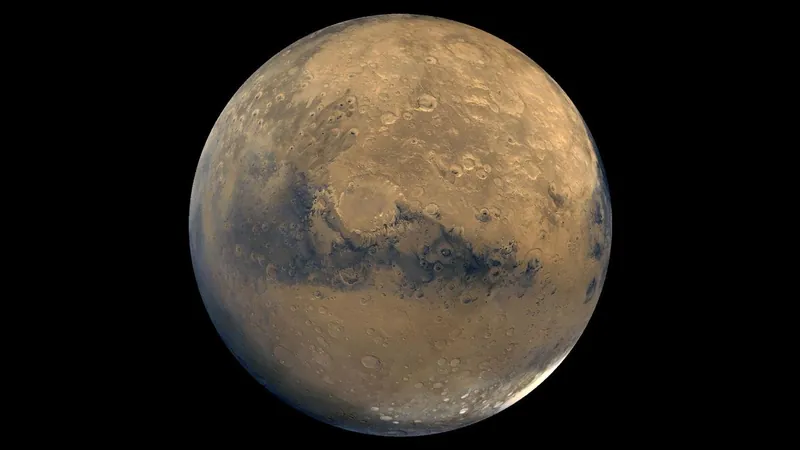
Major Twist in Mars Research: Could Magnetic Field Have Supported Ancient Life Longer Than Believed?
2024-11-04
Author: Olivia
Major Twist in Mars Research: Could Magnetic Field Have Supported Ancient Life Longer Than Believed?
Recent groundbreaking research suggests that Mars' magnetic field might have persisted for a staggering 200 million years longer than previously thought, a time frame potentially crucial for the existence of liquid water on the planet's surface. This revelation could reshape our understanding of Mars' ancient environment and its capacity to harbor life.
A team of planetary scientists from Harvard University, led by Sarah Steele, conducted the study which indicates that the phenomenon of magnetic pole reversals may have misled previous researchers into believing that Mars' magnetic dynamo had ceased functioning during its early history. Their findings underscore the importance of studying Mars' magnetic field as it relates to the planet's geological and atmospheric evolution.
Steele emphasized, “We are trying to answer fundamental questions about how everything came to be as it is, including the entire solar system.” By unveiling insights about planetary magnetic fields, researchers can probe deeper into the ancient histories of planets like Mars.
Unlike Earth’s robust iron-nickel core that sustains a strong geodynamo, Mars, which is approximately half the size of our planet, experienced a rapid cooling of its geodynamo. This shift in temperature led to the eventual halt of its magnetic field, leaving the planet vulnerable to solar winds that gradually stripped away its atmosphere and water.
Previously, scientists believed that this magnetic shield disintegrated over 4.1 billion years ago when Mars was bombarded by massive asteroid impacts. The absence of magnetic records in the impact basins was interpreted as evidence that the dynamos had fully ceased operation. However, the latest study proposes a different narrative. The research team scrutinized the Martian meteorite Allan Hills 84001 and discovered indications of magnetic reversals, suggesting that the global magnetic field might not have disappeared but rather been in a state of flux during the formation of impact basins.
Steele and her colleagues have backed this theory with advanced computer modeling, which proposes that during the pole reversals, ferromagnetic minerals could not firmly align, leading to an apparent reduction in the magnetic field's strength. If validated, this would mean the Martian magnetic field potentially survived until 3.9 billion years ago, providing a longer window during which conditions were possibly more favorable for life.
This expanded timeline holds significant implications for the history of water on Mars. The overlap between the potential survival of the magnetic field and the era when surface liquid water existed could suggest that early life forms might have had a chance to thrive in a relatively protected environment shielded from harmful cosmic radiation.
Moreover, this new understanding may alter scientists' assessments of atmospheric loss rates on Mars. NASA's MAVEN orbiter is currently analyzing the planet's atmosphere, allowing researchers to gauge the extent of atmospheric erosion over time. If the magnetic field endured longer, atmospheric depletion might have started later, necessitating a reevaluation of the historical conditions on Mars.
As planetary scientists continue to investigate the depths of Mars' past, these revelations promise to expand our knowledge and could potentially redirect future explorations aimed at uncovering the mysteries of life beyond Earth. If life ever did arise on Mars, this updated understanding might bring us one step closer to finding the tantalizing evidence of its existence.









 Brasil (PT)
Brasil (PT)
 Canada (EN)
Canada (EN)
 Chile (ES)
Chile (ES)
 Česko (CS)
Česko (CS)
 대한민국 (KO)
대한민국 (KO)
 España (ES)
España (ES)
 France (FR)
France (FR)
 Hong Kong (EN)
Hong Kong (EN)
 Italia (IT)
Italia (IT)
 日本 (JA)
日本 (JA)
 Magyarország (HU)
Magyarország (HU)
 Norge (NO)
Norge (NO)
 Polska (PL)
Polska (PL)
 Schweiz (DE)
Schweiz (DE)
 Singapore (EN)
Singapore (EN)
 Sverige (SV)
Sverige (SV)
 Suomi (FI)
Suomi (FI)
 Türkiye (TR)
Türkiye (TR)
 الإمارات العربية المتحدة (AR)
الإمارات العربية المتحدة (AR)